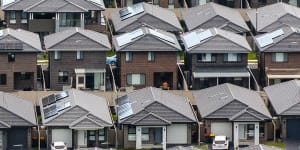There’s also lingering worries about population;66 per cent of voters believe last year’s migration intake was too high,.

Housing and population loom as key battlegrounds at the next federal election.Wolter Peeters
Federal Opposition Leader Peter Dutton ensured housing and population will be key battlegrounds at the next federal election by using his budget reply this month to promise deep cuts to permanent migration to take pressure off property prices and rents. Home Affairs Minister Clare O’Neil claims the Labor government is already on track to halve overseas migration by next financial year.
So how have fluctuations in population affected housing costs in Sydney? And are migration cuts the solution to Sydney’s accommodation crisis?
Population rollercoaster
The political war of words over migration and housing follows roller coaster population growth since the onset of COVID-19.
Border closures during the pandemic sent Sydney’s population into decline in 2020-21 but a strong recovery in migration since has pushed growth rates to historic highs.

Sydney’s population growth rate hit a robust 2.8 per cent last financial year driven by the post-COVID catch-up in migration,although that was still slower than in Perth (3.6 per cent),Melbourne (3.3 per cent) and Brisbane (3.1 per cent).
The population whiplash caused by COVID-19 can be deceptive;Sydney’s long-term population trajectory remains broadly consistent with the pre-COVID trend. Since the onset of the pandemic in 2020 net overseas migration (the number of people arriving minus the numbers leaving) has averaged about 65,000 annually,a little lower than the two years before the pandemic.
Housing squeeze
Grattan Institute economist Brendan Coates says Sydney population is “lower than what we expected it to be at this point” based on pre-pandemic forecasts.
Even so,the sheer pace of recent population growth has exacerbated long-standing pressures in the housing market. The last NSW budget warned that “the post-pandemic return of migration” has left the state’s housing supply “struggling to catch up to demand”.
AMP chief economist Dr Shane Oliver says that without the recent population surge,“we would probably be seeing lower prices” for housing in Sydney.
Meanwhile,Domain figures show Sydney’s median asking rent reached a record high of $750 in the March quarter and the city’s rental vacancy rate remained at an all-time low of 0.8 per cent.
International students return
Many of those arriving in Sydney from overseas are international students returning to complete their studies,or begin new courses,as the higher education sector normalises after pandemic upheavals. International education is a major contributor to Sydney’s economy and supports many local jobs.
The departure of international students en masse during the COVID-19 crisis triggered a population slump in some Sydney suburbs adjacent to universities. But numbers in those areas recovered sharply since border restrictions were lifted.
While many international students move into accommodation specifically for students,Coates says rental vacancy rates “would not be this tight in Sydney and Melbourne if it wasn’t for the return of so many students so quickly”.
But overseas migration isn’t the only thing stoking demand for housing.
“To solely focus on population growth as the thing that’s underpinned the situation that we’ve got in Sydney’s housing market today is ill-informed,” says Domain’s research and economics chief Nicola Powell. “There are many things at play.”
More living space
During the pandemic,there was a shift in preferences towards having more physical living space at home as lockdowns restricted movements.
This trend has persisted;Coates says the number of people per household nationally has fallen from 2.55 to around 2.48 since the pandemic.
That might not sound much,but when spread across the whole population it equates to a big increase in demand for housing.

The desire for extra room to work from home and the ageing of the population have contributed to this trend which is showing up in demographic data. Many well-located Sydney suburbs
Coates says the preference for more living space has been even more important than population in lifting demand for housing.
“The biggest thing that’s changed is not about population,it’s that Australians,including Sydneysiders,are demanding more housing than they did before the pandemic,” he says.
The past two years have been marked by rising interest rates which is also shaping housing dynamics across the city,including for renters.
KPMG urban economist Terry Rawnsley says there has been a strong correlation between rising rents and rising interest rates since the Reserve Bank began lifting the official cash rate in May 2022 to combat inflation. Many landlords have responded to higher interest costs by lifting rents.

“Population is definitely a part of Sydney’s housing story,but there’s really a complex mix of factors at work,” says Rawnsley.
Perfect storm
Sydney’s housing problems have been aggravated by inadequate supply as rising rates and soaring building costs inhibit the construction of new homes.
“A chronic shortage of housing existed before the population boom,” says Oliver,who estimates Sydney’s housing market is now under-supplied by 70,000 to 80,000 dwellings.
Despite high property prices and rising rents,residential building approvals are lagging. To make matters worse,Sydney has
In this month,Reserve Bank assistant governor Sarah Hunter said multiple challenges,especially high construction prices,have created “a perfect storm of constraints” on new development.
“Pandemic-related supply chain disruptions and competition for resources from other types of construction have pushed up prices significantly,by nearly 40 per cent since late 2019,” she said.
Many residential projects have been delayed or cancelled as a result of rising interest rates and high costs.

The post-COVID population spike will be temporary. Last December the NSW government was already forecasting the state’s population growth would slow to 1.3 per cent in 2024-25,comparable to pre-Covid rates.
But fixing Sydney’s chronic housing supply problems will take many years.
The Morning Edition newsletter is our guide to the day’s most important and interesting stories,analysis and insights..